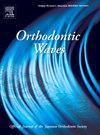Effects of dental arch size variation on orthodontic forces delivered by preformed Ni-Ti archwires
IF 0.5
Q4 DENTISTRY, ORAL SURGERY & MEDICINE
引用次数: 0
Abstract
ABSTRACT Purpose The purpose of the present study was to investigate the effect of the size variation of the mandibular dental arch on the magnitude and direction of orthodontic forces delivered by a variety of commercially available preformed rectangular Ni-Ti archwires. Materials and methods The means and standard deviations (SDs) of intercanine and intermolar widths and the means of dental arch depths at the canines and first molars were established based on our previous studies of subjects with untreated normal occlusions. The mandibular dental arch of a multi-sensor measuring system was adjusted to the mean, enlarged to +1SD and reduced to −1SD sizes of the normal dental arch. Fifty-nine types of 0.019 × 0.025-inch NiTi archwires were selected, and the intercanine and intermolar widths of the archwires were measured. Delivered forces were measured at the central incisors, canines, and first molars for each dental arch condition. Results Significant correlations were found between archwire width and forces at all examined teeth for all dental arch widths. Significantly greater facial direction forces were delivered at the central incisor for the large dental arch condition than for the small and mean dental arch conditions. Significantly greater facial direction force was delivered at the canines for the small dental arch than for the large dental arch condition. Conclusion Possible risks of clinically significant magnitudes of orthodontic force in the facial direction at the central incisors and canines were observed when using preformed rectangular NiTi archwires for patients with relatively large and small dental arches, respectively.牙弓尺寸变化对预制镍钛弓丝正畸力的影响
摘要目的本研究的目的是研究下颌牙弓的尺寸变化对各种市售预制矩形镍钛弓丝施加的正畸力的大小和方向的影响。材料和方法基于我们之前对未经治疗的正常咬合受试者的研究,建立了犬齿和第一磨牙齿间宽度和齿间宽度的平均值和标准差(SD)以及牙弓深度的平均值。将多传感器测量系统的下颌牙弓调整为正常牙弓的平均值,放大至+1SD,缩小至-1SD。选择59种0.019×0.025英寸镍钛弓丝,测量了弓丝的齿间宽度和齿间宽度。测量每种牙弓条件下中切牙、犬齿和第一磨牙的传递力。结果对于所有牙弓宽度,弓丝宽度与所有检查牙齿的受力之间存在显著相关性。与小牙弓和平均牙弓条件相比,大牙弓条件下在中切牙处传递的面部方向力显著更大。小牙弓的犬科动物受到的面部方向力明显大于大牙弓的情况。结论对于较大和较小牙弓的患者,分别使用预制矩形NiTi弓丝时,观察到中切牙和犬齿在面部方向上的正畸力可能具有临床意义的风险。
本文章由计算机程序翻译,如有差异,请以英文原文为准。
求助全文
约1分钟内获得全文
求助全文
来源期刊

Orthodontic Waves
DENTISTRY, ORAL SURGERY & MEDICINE-
CiteScore
0.40
自引率
0.00%
发文量
0
期刊介绍:
Orthodontic Waves is the official publication of the Japanese Orthodontic Society. The aim of this journal is to foster the advancement of orthodontic research and practice. The journal seeks to publish original articles (i) definitive reports of wide interest to the orthodontic community, (ii) Case Reports and (iii) Short Communications. Research papers stand on the scientific basis of orthodontics. Clinical topics covered include all techniques and approaches to treatment planning. All submissions are subject to peer review.
 求助内容:
求助内容: 应助结果提醒方式:
应助结果提醒方式:


